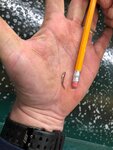

Southwest Washington’s Merwin Reservoir is a well-known destination for kokanee anglers who flock here to catch a limit of landlocked sockeye salmon. The reservoir was formed in 1931 after Merwin Dam was built along the Lewis River. There is a hatchery in Speelyai Creek at the north end of the reservoir which provides some 93,000 kokanee a year for the lake; other kokanee naturally spawn in Speelyai Creek and Speelyai Bay.
Today, PacifiCorp operates the dam which generates hydropower electricity. They also fund the fish hatchery with the Cowlitz County PUD. The Washington Department of Fish and Wildlife operates the hatchery. In January, PacifiCorp drew down the water levels of the reservoir 25 feet to perform maintenance on the dam.
Dennis Schwartz is an avid kokanee angler and former federal fisheries biologist. He reached out to me regarding the drawdown, concerned emerging kokanee fry naturally spawned by kokanee in Speelyai Creek had been left high and dry by the drawdown. Schwartz had inquired about it and relayed the local WDFW fisheries biologists had not been consulted about this drawdown prior to it occurring.
I reached out to Ben Anderson, a Public Affairs Officer for the Washington Department of Fish and Wildlife. He said, “We’ve heard concerns about how the recent drawdown at Lake Merwin may have impacted kokanee in the lake. It’s true that the fish most likely to be affected by the drawdown would be recently hatched fry in areas where water was low/no longer present, including in Speelyai Creek. Fish further along in their life cycle would likely move with the dropping water level and are unlikely to be impacted.”
Anderson went on to say, “A WDFW biologist who visited the site on Jan. 21 saw no evidence of die-offs, but impacts to newly emerged fry in the gravel can be difficult to identify. Our biologist did observe that preferential spawning areas were till mostly watered up, and impacts of the drawdown were likely limited to less-preferred spawning habitat on the lake margins.
At this time, we don’t have evidence of a significant impact to the naturally spawning kokanee population. PacifiCorp also sent out some staff in a boat to look for any signs of fish impact in the nearshore area and did not identify an impact.”
Asked whether WDFW was in the loop about the drawdown prior to it occurring Anderson replied, “WDFW was not consulted or notified prior to the drawdown. PacifiCorp’s hydropower operating license does allow for these alterations to occur. PacifiCorp typically makes us aware of any significant changes to reservoir levels ahead of time, but it didn’t happen in this case and staff have connected with PacifiCorp to discuss the continued importance of consulting with WDFW in the future.”
Drew Hanson is a spokesman for PacifiCorp. From his response it appears PacifiCorp did not coordinate with WDFW prior to the drawdown but did so during it. In his words, “WDFW hatchery staff were notified verbally of the drawdown prior to reaching a significant reservoir elevation. At that time, we paused to assess a potential water supply impact to Merwin Hatchery. After assuring the water supply would remain available, PacifiCorp notified WDFW regional fisheries management via email of drawdown. PacifiCorp recognizes that WDFW has a vested interest in reservoir access and sees an opportunity to provide WDFW Hatchery and Fisheries Management staff additional notice of unique drawdown events.”
Another person I spoke with about this issue is Duane Inglin, the host of “Fish Hunt Northwest” and a person very knowledgeable about cold-water fisheries in Western Washington. Inglin, Anderson and Schwartz all agree that nobody really knows how much the naturally spawning kokanee contribute to the overall health of the fishery. As Inglin told me, we probably won’t know how significant this event was to the kokanee in Lake Merwin for four years. That’s when these emerging fry will be full-grown adults and return to Speelyai Creek to spawn.
Until then, Dennis Schwartz’s efforts have spurred a conversation that will hopefully lead to better coordination between PacifiCorp and WDFW with an eye towards monitoring the kokanee population in Merwin Reservoir to better understand it and further manage a healthy fishery here.
John Kruse – www.northwesternoutdoors.com and www.americaoutdoorsradio.com
Comments
No comments on this item Please log in to comment by clicking here